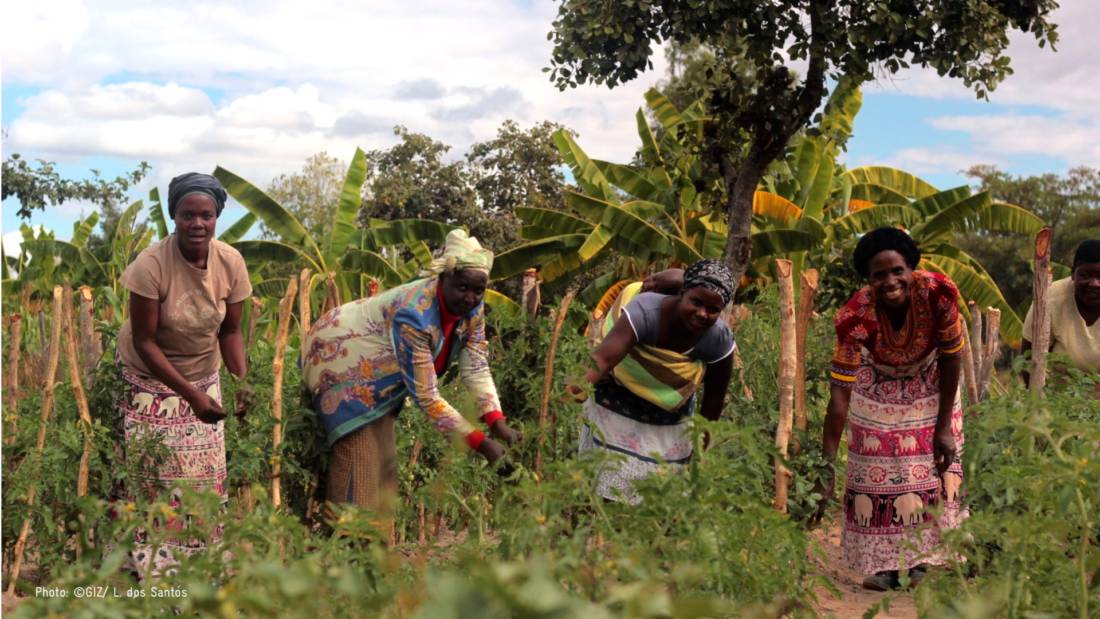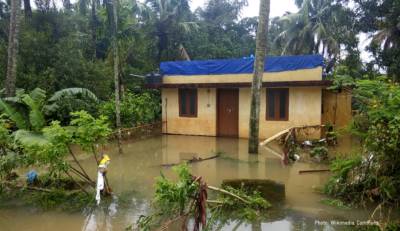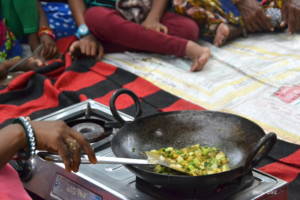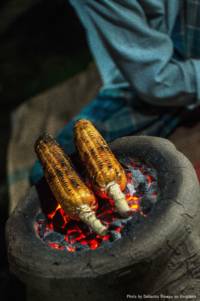Building Resilience — Are We Making Progress?
Towards a common understanding of resilience building — thoughts on the state and prospects of this critical goal

What would be if?
Since the beginning of July 2018, severe floods have affected the south Indian state of Kerala due to unusually high rainfall during the monsoon season. It was the worst flooding in Kerala in nearly a century. As of September over 483 people died, 38 are still missing.
That’s the harsh reality. But let’s consider the case of an imaginary community. Think of a rural community that was only marginally affected by the floods because it had taken some preventive measures beforehand. An embankment management committee had coordinated plantation activities to stabilize embankments and the community had jointly prepared a development plan that rules out any constructions in the floodplains. The fertile land in the floodplains was commonly used by community members and small local businesses contributed to a diversified income base. Food grains and food commodities were stored safely. Households affected by the floods were provided emergency loans to compensate for agricultural losses and damage to their houses by a community savings scheme. — All in all, this is arguably what one would call resilience.

Unfortunately, this community doesn’t exist to the best of our knowledge. Media reports paint a grim picture: More than 100,000 people are cut off from vital infrastructures. Access to clean water, food and communications is severely hampered. How could it be more evident? Resilience building is not merely a theoretical concept. Though, unfortunately, quite often it is simply used a buzzword, an objective without explicit and realistic measures planned to achieve it.
Why resilience?
Because weather and climate conditions are becoming more extreme. Demographic pressure on natural and economic resources is on the rise, and the number of people displaced by war, conflicts and extreme weather events is reaching historic highs. Building resilience is of great significance to many sectors and development programmes. For this reason, the working group on Food Security, Nutrition and Resilience chose resilience as a focus theme for the recent issue of the SNRD Africa newsletter.
The working group wishes to gain deeper insights into how projects and other sectors deal with resilience building as well as the common obstacles faced on the way. The group commenced a new work stream on nutrition and resilience, which aims at reaching a better understanding of what exactly is meant by resilience within their context. Encouraging exchange and learning across sectors feeding into a concept — or rather for a clearer objective — used in multiple sectors is among the first milestones of the work stream.
The working group wishes to emphasize that resilience building can be a common denominator of projects across sectors, and as such provides an opportunity for productive collaboration. That is if considered seriously and not only misused as a buzzword in project communications or as means to tick off boxes in the documentation. With the article at hand, the working group shares initial insights into the concept of resilience and initial thoughts as to where projects in development cooperation need improvement.
Understanding resilience
The concept of resilience was originally devised in ecology, which is the branch of biology that deals with the relations of organisms to one another and to their physical surroundings:

In ecology, resilience determines the persistence of relationships within a system and the ability of an ecosystem to respond to a shock by withstanding damage and recovering quickly. Since the end of the 1980s, resilience has also been used to analyze how humans deal with stress, shocks, or change. Today, numerous context-specific definitions exist, while all revolve around the essence of resilience, namely those factors of a system that enable it to continue under adverse conditions and shocks.
In development cooperation, the concept has become mainly driven by disaster risk management and transitional development assistance. Germany’s Federal Ministry for Economic Cooperation and Development (BMZ), for instance, has this understanding of resilience:
“Resilience is the ability of people and institutions – be they individuals, households, communities or nations – to deal with acute shocks or chronic burdens or stress caused by fragility, crises, violent conflicts and extreme natural events, adapting and recovering quickly without jeopardising their medium and long-term future” (BMZ 2013).
Three types of capacities
Broadly speaking, resilience entails enhancing three capacities: the capacity to absorb or cope, to adapt and transform. The meaning may differ according to the actual context and sector but generally each capacity can be defined as follows:
Absorptive capacities refer to coping skills enabling individuals, households, communities or states to deal with or moderate adverse effects of shocks. This generally includes human, financial, social, and natural capital. In food and nutrition security, this could be the availability of financial resources to buy nutritious food even under drought conditions. It could, however, also refer to negative coping capacities jeopardizing future development opportunities, such as reducing food intake or selling productive assets in order to buy food. In the short-term, even negative coping capacities may contribute to stability, such as relatively stable food intake.
Adaptive capacities enable individuals or respective socio-ecological or socio-economic systems to incrementally adjust to the impacts of shocks, stress, or change. This includes the diversification of agricultural production or income sources to better deal with climate variability and change or enhanced sanitation infrastructure to adapt to more severe floods.
Transformative capacities are enabled through structural and systemic change. This implies changing an entire way of life, e.g. transforming subsistence farming into for-profit agriculture or the empowerment of women through improved access to finance and behavioural change within a community or society.
How good are we at resilience building?
To answer this question at project level would require comprehensive research and analysis. It would be advisable to apply a case by case or project by project approach. However, there are global trends which give some indication, for instance:
- Globally, hunger is on the rise — the estimated number of undernourished people increased from 783.7 million in 2014 to 820.8 million in 2017 (FAO 2018)
- An increase of conflicts worldwide in recent years
- Land degradation undermining the well-being of 3.2 billion people — expansion and mismanagement of croplands and grazing lands being the most extensive driver of it (ipbes 2018)
These worrying trends increasing the vulnerability and exposure of people to shocks bring the working group to the conviction: “We have to get way better!”
What’s going on at project level?

Many projects define the strengthening of resilience as their key goal. Subjected to scrutiny, however, they tend to lack specific action with regard to the related objectives and approaches. Any project aiming to deliver tangible results in the area of resilience strengthening should be able to answer these fundamental questions:
- Resilience of what? — Is my approach geared towards a specific livelihood system or, as an example, a food and nutrition security system in general?
- Resilience to what? — Are my objectives addressing climate variability and change, economic crises from a systemic perspective or rather shocks that threaten the livelihoods of individuals, such as illnesses or unemployment?
- Resilience of whom? — Is the action targeting a country, an explicit part of a population, or specific communities?
- Resilience with respect to what — Is the project addressing basic security needs, poverty, or general well-being?
- Resilience over what time frame — Are the measures short or medium-term, for example, to withstand weather extremes, or long-term to deal with the effects of ongoing climate change?
The working group is under the impression that many projects claim their efforts contributed to the strengthening of resilience in somehow general terms — for example against natural disasters, food insecurity or conflict. Surely, these are grand schemes entailing major tasks that can hardly be achieved by a single project alone. However, this should not lead to a situation wherein basically any development activity would be automatically subsumable under the category resilience strengthened. This practice disadvantageously contributes to using resilience as a communication label without having any explicit project activity defined.
Building resilience requires analyzing and scrutinizing the measures applied to ensure that they explicitly strengthen resilience in a specific context, over a specific time frame and all its capacities. Numerous frameworks to perform thorough context analyses and to define targeted measures exist — especially from the fields of disaster risk management, climate change and transitional development assistance. There is thus a lot to build on and to learn from, for example when defining what resilience means in the context of food and nutrition security.
Focusing on absorptive and adaptive capacity
Strengthening transformative capacities is certainly the most difficult aspect of resilience, which leads the working group to their second observation: in the context of more challenging environments — be it conflict situations, climate change, high urbanization or stunting rates — it is as much tempting as it is critical to give attention to absorptive and adaptive capacities. This is exactly what most development projects do.
Regarding these two capacities, various successful approaches exist. Let’s have a brief look at two examples with a particular focus on absorptive and adaptive capacities:
In Malawi, nutrition-sensitive cash transfers helped prevent negative coping strategies after the exceptionally strong El Niño in the 2015/2016 season. Combined with trainings on irrigation and improved water storage and the promotion of seeds and seedlings for kitchen gardens adaptive capacities were strengthened.
The diversification of agricultural production and diets through integrated homestead farming have enabled rural households to generate additional income, which helps them to better deal with seasonal food shortages. At the same time, it encourages the use of crops that are more adapted to changing climatic conditions and further builds adaptive capacities in the medium term.

In India, the promotion of proper seed storage helps communities protect seeds for the next planting season and it reduces the amount of cash needed for recurring investments in agricultural inputs. As a result, households have additional financial resources available to them.
Dealing with the long-term perspective
The state of being resilient entails both the capacity to respond to immediate needs as well as to aspects of more fundamental development progress. This cannot be achieved in short time frames — certainly not within a single project cycle. Especially, the strengthening of the capacity to transform requires a long-term and multi-sectoral perspective many projects are not designed for. However, development cooperation projects can initiate structural change towards building resilience. Whether higher levels of resilience are reached can only be verified after some time has passed.
In the area of nutrition, achieving behavior change, such as diversifying mainly maize or rice-based diets, changing breastfeeding habits, or empowering women to make household decisions, is a major challenge. We already have measures and approaches in place — for stronger male engagement for example — but changing habits and power structures requires cross-sectoral cooperation and approaches.

For example, the empowerment of women is difficult without their financial and economic inclusion. Or dietary diversification can hardly be achieved without agriculture providing for it. The reduction of stunting rates relies on improvements in health and sanitation. And food security is only within reach when appropriate climate change mitigation and adaptation is being accomplished and economic stability has improved overall.
What makes these kinds of endeavors complicated is that they are not unidirectional. Many goals also become means. Food security is both an essential “input” for resilience as it is an outcome of being resilient. Consequently, resilience does not exist when basic food and nutrition needs are not fulfilled, which is relevant for other sectors aiming at strengthening resilience.
In conclusion
Resilience can be a bridging concept and an objective shared between and across sectors. In order to fulfill this expectation, all aspects of resilience must be explicitly reflected in and strengthened by a project’s approach – ideally in cooperation with other projects and partners.
In the future, there should be a stronger focus on the transformative dimension of resilience with the prospect of initiating systemic change and progress.
The working group is eager to learn how other projects are working with the notion of resilience — especially with strengthening transformative capacities. We hope you’ll enjoy reading this newsletter issue and feel inspired for your future endeavors.
The authors
The article above leads SNRD Africa’s newsletter #5 and has been contributed by Susanne Schwan, Archana Sarkar and Sarah-Kay Schotte of the Food Security, Nutrition and Resilience working group.
References and further reading
- BMZ (Federal Ministry for Economic Cooperation and Development). 2010-2018. Transitional development assistance. Enhancing resilience – building connectedness. Berlin. www.bmz.de/en/issues/transitional-development-assistance/index.html.
- FAO (Food and Agriculture Organization of the United Nations). 2018. In brief the state of food security and nutrition in the world. Building climate resilience for food security and nutrition. Rome. www.fao.org/3/CA1354EN/ca1354en.pdf.
- FAO (Food and Agriculture Organization of the United Nations). 2016a. Resilience Index Measurement and Analysis – II: Moving Forward the Development of the Resilience Index Measurement and Analysis Model. Rome. www.fao.org/resilience/resources/resources-detail/en/c/405048/.
- FAO (Food and Agriculture Organization of the United Nations). 2016b. Strengthening the links between resilience and nutrition in food and agriculture. Rome. www.fao.org/3/a-i3824e.pdf.
- IPBES (Intergovernmental Science-Policy Platform on Biodiversity and Ecosystem Services). 2018. Media release: worsening worldwide land degradation now ‘critical’, undermining well-being of 3.2 billion people. Bonn. www.ipbes.net/news/media-release-worsening-worldwide-land-degradation-now-%E2%80%98critical%E2%80%99-undermining-well-being-32.
- GIZ (Deutsche Gesellschaft für Internationale Zusammenarbeit GmbH). 2016. Boosting Resilience in Fragile Contexts. A field-tested approach of the Resilience Learning Initiative.
- Holling C. 1973. Resilience and stability of ecological systems. Annual Review of Ecology and Systematics 4:1–23. DOI 10.1146/annurev.es.04.110173.000245.
- Ifejika Speranza C, Wiesmann U, Rist S. 2014. An indicator framework for assessing livelihood resilience in the context of social-ecological dynamics. Global Environmental Change 28:110. DOI 10.1016/j.gloenvcha.2014.06.005.
- Maxwell D, Constas M, Frankenberger T et al. 2015. Qualitative Data and Subjective Indicators for Resilience Measurement. Resilience Measurement Technical Working Group. Technical Series No. 4. Rome: Food Security Information Network. www.fsincop.net/fileadmin/user_upload/fsin/docs/resources/1_FSIN_TechnicalSeries_4.pdf.
- Tendall DM, Joerin J, Kopainsky B et al. 2015. Food System Resilience: Defining the Concept. Global Food Security 6:17–23. DOI 10.1016/j.gfs.2015.08.001.

